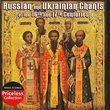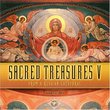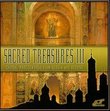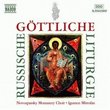| All Artists: Russian Orthodox Chant Title: La Divine Liturgie de Saint-Jean Chrysostome Members Wishing: 0 Total Copies: 0 Label: Harmonia Mundi Release Date: 12/14/1999 Album Type: Import Genres: Special Interest, Classical Style: Opera & Classical Vocal Number of Discs: 1 SwapaCD Credits: 1 UPC: 794881478125 |
Search - Russian Orthodox Chant :: La Divine Liturgie de Saint-Jean Chrysostome
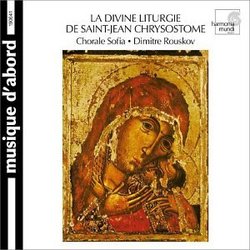 | Russian Orthodox Chant La Divine Liturgie de Saint-Jean Chrysostome Genres: Special Interest, Classical |
Larger Image |
CD DetailsSimilar CDs |
CD ReviewsChrist is with us in his real flesh and blood Jacques COULARDEAU | OLLIERGUES France | 06/30/2008 (5 out of 5 stars) "Based essentially as it tarts on the bass recitative and the choir's response, we get the impression of a dominant and transcending dimension of God in his human fate ordering project or vision into which the choir of the faithful, of the other voices are supposed to, are attempting to, are succeeding to penetrate, merge into elevation and inspiration. At times a median voice I could consider a baritone is relaying the bass in the recitative, like a go-between, an intercessor pulling us up into communion with the kingdom of God. Thus it is a constructive contemplative journey we are taking in the heart of our faith, in the soul of our fate, in the immensity of God's creation, ordeals and salvation. The readings, recitatives by definition, are going up stage after stage, step after step to bring the faithful to the kingdom of God those readings are supposed to evoke. The very melody of the bass and baritone recitatives is the pilgrim's progress to eternity. And when that glimpse has been made possible, the Cherubim can come into the enclosed contemplation of heavens and salvation in our souls to solidify the harmony and extreme satiating balance of the contact with this quenching eternity, this divine satisfied lust for eternity. And this eternity can only be reached through the offertory, the real transmutation of the bread and the wine into the real body and blood of Christ, the transmutation of the sacrifice of Christ on the cross into the salvation of our souls via the empathy with the martyrdom and the total merging with the vision of this transcendence beyond that comes from deep inside and reverberates in our brains without ever stopping. A kiss of peace from God, an embrace of love from Christ. With the consecration the recitative baritone takes a new bend in its melody building with a sentence ending in a loop, a going down balancing loop before jumping into a distant cry for the miracle of the transfiguration of the bread and wine. The choir responds then with a low, slow and deep dirge of veneration, death of Christ and faith of the congregation together. The consecration of our faith in its possibility. And this brings the Holy Virgin Mary into the prayer that resembles a hymn of thanks for her gift to humanity and a prayer of compassion for us in her eternal intercession from the birth of Christ to his Second Coming. The Virgin Mary associated to the announced communion in this liturgical piece. And there comes the Oration, the absolute belief in the miracle of the contact, direct and total, with Christ in his martyrdom and resurrection. There the tenors take us up into the light of the Sunday morning when the grave is found empty. The communion is then finally possible in the bread and the blood since it has already taken place in our souls. And the last prayers can sustain this immersion into the divine to prepare us for confronting the outside world when we step out of this bubble of sanctity.
Dr Jacques COULARDEAU, University Paris Dauphine, University Paris 1 Pantheon Sorbonne & University Versailles Saint Quentin en Yvelines " |

